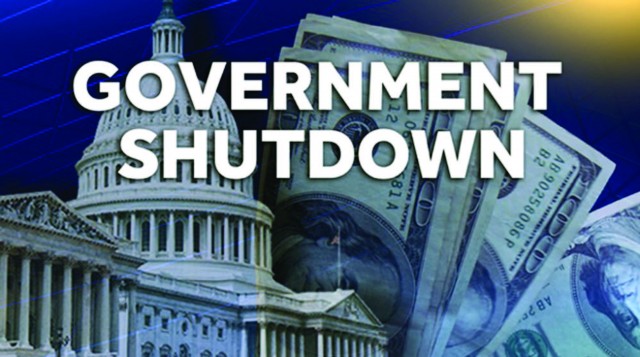In U.S. politics, a government shutdown is a situation in which Congress fails to pass authorization for sufficient funds for government operations. Typically, the government stops providing all but “essential” services at first, but since Congress must authorize all expenditures, there is no law protecting any government service from stoppage. Federal services that may continue for a time after a shutdown include the National Weather Service and its parent agencies, medical services at federal facilities, armed forces, air traffic management, and corrections (the penal system). During the Ford and Carter administrations, there were 6 partial government shutdowns that affected only the departments of Labor and Health, Education, and Welfare. These partial shutdowns lasted from 8 to 18 days and the primary issue of dispute was federal funding for abortion. During the Reagan administration, there were 8 full government shutdowns that lasted only 1 to 3 days each, primarily over the issue of the United States budget deficit. There was a similar 4-day shutdown during the first Bush administration. During the Clinton administration, after conservatives made massive congressional gains in the 1994 Republican Revolution, there were two full government shutdowns lasting 5 and 21 days respectively, the second of which was by far the longest of its kind to that date. The primary issue was again the United States budget deficit. The United States federal government shutdown of 2013 is ongoing, having begun on 1 October 2013. The primary issue of dispute between the Republican-controlled House of Representatives and the Democratcontrolled Senate (the latter supported by President Obama) is the Republicans’ desire to oppose the Affordable Care Act, signed into law in 2010.
Mechanism of a Shutdown
Under the separation of powers created by the United States Constitution, both the Senate and House of Representatives must approve an agreed budget, which then goes to the President of the United States for signature. If the President vetoes the budget, it goes back to Congress, where the veto can be overridden by a two-thirds vote. Government shutdowns tend to occur when the President and one or both of the chambers of Congress are unable to resolve disagreements over budget allocations before the existing budget cycle ends. Shutdowns of the type experienced by the United States are nearly impossible in other democracies. Under the parliamentary system used in most European nations, the executive and legislative branch are not separate, with the parliament designating all executive officials, typically called “ministers”. In non-parliamentary democracies, a strong executive branch typically has the authority to keep the government functioning even without an approved budget. This was the case in the United States up until 1980, when the administration of Jimmy Carter interpreted the 1884 Antideficiency Act to limit the power of federal agencies in the lack of congressional approval.
What’s Affected by a Government Shutdown?
Below, find an overview of some of the government services and operations that will be impacted until Congress passes a budget to fund them again. * Vital services that ensure seniors and young children have access to healthy food and meals may not have sufficient Federal funds to serve all beneficiaries in an extended lapse. * Call centers, hotlines and regional offices that help veterans understand their benefits will close to the public. * Veterans’ compensation, pension, education, and other benefits could be cut off in the case of an extended shutdown. * Every one of America’s national parks and monuments, from Yosemite to the Smithsonian to the Statue of Liberty, will be immediately closed. * New applications for small business loans and loan guarantees will be immediately halted. * Research into life-threatening diseases and other areas will stop, and new patients won’t be accepted into clinical trials at the National Institutes of Health. * Work to protect consumers, ranging from child product safety to financial security to the safety of hazardous waste facilities, will cease.
The EPA will halt non-essential inspections of chemical facilities and drinking water systems. * Permits and reviews for planned energy and transportations projects will stop, preventing companies from working on these projects. Loans to rural communities will be halted. * Hundreds of thousands of Federal employees including many charged with protecting us from terrorist threats, defending our borders, inspecting our food, and keeping our skies safe will work without pay until the shutdown ends. * Hundreds of thousands of additional federal workers will be immediately and indefinitely furloughed without pay. Shutdowns in the past have also affected the Washington, D.C., municipal government, closing schools and suspending utilities such as garbage collection. Starting in 1976, the United States Federal Government has shut down on 18 occasions. The highest number of shutdowns-8- was in the Presidency of Reagan, followed by 5 in the presidency of Carter.
